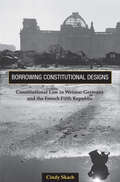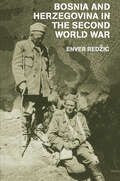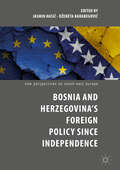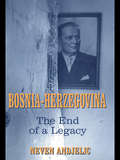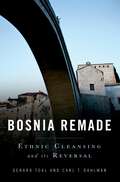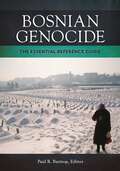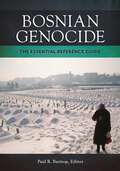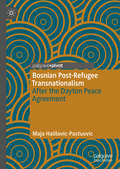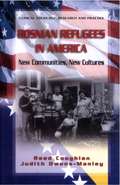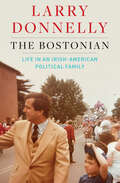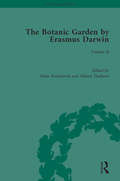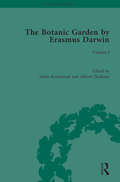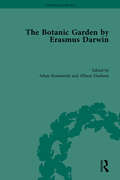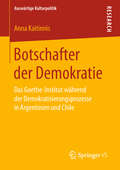- Table View
- List View
Borrowing Constitutional Designs: Constitutional Law in Weimar Germany and the French Fifth Republic
by Cindy SkachAfter the collapse of communism, some thirty countries scrambled to craft democratic constitutions. Surprisingly, the constitutional model they most often chose was neither the pure parliamentary model found in most of Western Europe at the time, nor the presidential model of the Americas. Rather, it was semi-presidentialism--a rare model known more generally as the "French type." This constitutional model melded elements of pure presidentialism with those of pure parliamentarism. Specifically, semi-presidentialism combined a popularly elected head of state with a head of government responsible to a legislature. Borrowing Constitutional Designs questions the hasty adoption of semi-presidentialism by new democracies. Drawing on rich case studies of two of the most important countries for European politics in the twentieth century--Weimar Germany and the French Fifth Republic--Cindy Skach offers the first theoretically focused, and historically grounded, analysis of semi-presidentialism and democracy. She demonstrates that constitutional choice matters, because under certain conditions, semi-presidentialism structures incentives that make democratic consolidation difficult or that actually contribute to democratic collapse. She offers a new theory of constitutional design, integrating insights from law and the social sciences. In doing so, Skach challenges both democratic theory and democratic practice. This book will be welcomed not only by scholars and practitioners of constitutional law but also by those in fields such as comparative politics, European politics and history, and international and public affairs.
Borrowing Constitutional Designs: Constitutional Law in Weimar Germany and the French Fifth Republic (PDF)
by Cindy SkachAfter the collapse of communism, some thirty countries scrambled to craft democratic constitutions. Surprisingly, the constitutional model they most often chose was neither the pure parliamentary model found in most of Western Europe at the time, nor the presidential model of the Americas. Rather, it was semi-presidentialism--a rare model known more generally as the "French type." This constitutional model melded elements of pure presidentialism with those of pure parliamentarism. Specifically, semi-presidentialism combined a popularly elected head of state with a head of government responsible to a legislature. Borrowing Constitutional Designs questions the hasty adoption of semi-presidentialism by new democracies. Drawing on rich case studies of two of the most important countries for European politics in the twentieth century--Weimar Germany and the French Fifth Republic--Cindy Skach offers the first theoretically focused, and historically grounded, analysis of semi-presidentialism and democracy. She demonstrates that constitutional choice matters, because under certain conditions, semi-presidentialism structures incentives that make democratic consolidation difficult or that actually contribute to democratic collapse. She offers a new theory of constitutional design, integrating insights from law and the social sciences. In doing so, Skach challenges both democratic theory and democratic practice. This book will be welcomed not only by scholars and practitioners of constitutional law but also by those in fields such as comparative politics, European politics and history, and international and public affairs.
Borrowing Credibility: Global Banks and Monetary Regimes (Michigan Studies In International Political Economy)
by Jana GrittersováNations with credible monetary regimes borrow at lower interest rates in international markets and are less likely to suffer speculative attacks and currency crises. While scholars typically attribute credibility to domestic institutions or international agreements, Jana Grittersová argues that when reputable multinational banks headquartered in Western Europe or North America open branches and subsidiaries within a nation, they enhance that nation’s monetary credibility. These banks enhance credibility by promoting financial transparency in the local system, improving the quality of banking regulation and supervision, and by serving as private lenders of last resort. Reputable multinational banks provide an enforcement mechanism for publicized economic policies, signaling to international financial markets that the host government is committed to low inflation and stable currency. Grittersová examines actual changes in government behavior of nations trying to gain legitimacy in international financial markets, and the ways in which perceptions of these nations change in relation to multinational banks. In addition to quantitative analysis of over 80 emerging-market countries, she offers extensive case studies of credibility building in the transition countries of Eastern Europe, Argentina in 2001, and the global financial crisis of 2008. Grittersová illuminates the complex interactions between multinational banks and national policymaking that characterize the process of financial globalization to reveal the importance of market confidence in a world of mobile capital.
Bosnia: Faking Democracy After Dayton
by David ChandlerThe Dayton Accords brought the Bosnian war to an end in November 1995, establishing a detailed framework for the reconstitution of the Bosnian state and its consolidation through a process of democratisation. *BR**BR*In Bosnia David Chandler makes the first in-depth critical analysis of the policies and impact of post-Dayton democratisation. Drawing on interviews with key officials within the OSCE in Bosnia and extensive original research exploring the impact of policies designed to further political pluralism, develop multi-ethnic administrations, protect human rights and support civil society, *BR**BR*Chandler reveals that the process has done virtually nothing to develop democracy in this troubled country. Political autonomy and accountability are now further away than at any time since the outbreak of the Bosnian war.
Bosnia and Herzegovina in the Second World War
by Enver RedzicFive major groups fought one another in Bosnia and Herzegovina during the Second World War: The German and Italian occupiers, the Serbian Chetniks, the Ustasha of the Independent State of Croatia, the Bosnian Muslims, and the Tito-led Partisans. The aims, policies, and actions of each group are examined in light of their own documents and those of rival groups. This work shows how the Partisans prevailed over other groups because of their ideological appeal, superior discipline, and success in winning the support of large numbers of uncommitted Bosnians, particularly the Bosnian Muslims.
Bosnia and Herzegovina in the Second World War
by Enver RedzicFive major groups fought one another in Bosnia and Herzegovina during the Second World War: The German and Italian occupiers, the Serbian Chetniks, the Ustasha of the Independent State of Croatia, the Bosnian Muslims, and the Tito-led Partisans. The aims, policies, and actions of each group are examined in light of their own documents and those of rival groups. This work shows how the Partisans prevailed over other groups because of their ideological appeal, superior discipline, and success in winning the support of large numbers of uncommitted Bosnians, particularly the Bosnian Muslims.
Bosnia and Herzegovina’s Foreign Policy Since Independence (New Perspectives on South-East Europe)
by Jasmin Hasić Dženeta KarabegovićThis book is the first to provide a comprehensive and systematic analysis of the foreign policy of Bosnia and Herzegovina, a post-conflict country with an active agency in international affairs. Bridging academic and policy debates, the book summarizes and further examines the first twenty-five years of BiH’s foreign policy following the country’s independence from Yugoslavia in 1992. Topics covered include conflict and post-conflict periods, Euro-Atlantic integration, political affairs on both local and regional levels, integration with a variety of international organizations and actors, neighboring states, bilateral relations with relevant other states including the United States, Russia, selected EU countries, and Turkey, as well as BiH’s diaspora. The book highlights that despite their apparent weakness, post-conflict states have agency to carry out foreign policy goals and engage with the international sphere, including in geopolitics, and thus provides a novel insight into weak states and their role in international politics.
Bosnia-Herzegovina: The End of a Legacy
by Dr Neven Andjelic Neven AndjelicWhen the war in Bosnia-Herzegovina broke out a baffled world sought explanations from a range of experts who offered a variety of reasons for the conflict. The author of this study takes Bosnian affairs seriously and in so doing makes it much easier to grasp why the war occurred.
Bosnia-Herzegovina: The End of a Legacy
by Dr Neven Andjelic Neven AndjelicWhen the war in Bosnia-Herzegovina broke out a baffled world sought explanations from a range of experts who offered a variety of reasons for the conflict. The author of this study takes Bosnian affairs seriously and in so doing makes it much easier to grasp why the war occurred.
Bosnia Remade: Ethnic Cleansing and its Reversal
by Carl T. Dahlman Gerard ToalBosnia Remade is an authoritative account of ethnic cleansing and its partial undoing from the onset of the 1990s Bosnian wars up through the present. Gerard Toal and Carl Dahlman combine a bird's-eye view of the entire war from onset to aftermath with a micro-level account of three towns that underwent ethnic cleansing and--later--the return of refugees. There have been two major attempts to remake the ethnic geography of Bosnia since 1991. In the first instance, ascendant ethno-nationalist forces tried to eradicate the mixed ethnic geographies of Bosnia's towns, villages and communities. These forces devastated tens of thousands of homes and lives, but they failed to destroy Bosnia-Herzegovina as a polity. In the second attempt, which followed the war, the international community, in league with Bosnian officials, endeavored to reverse the demographic and other consequences of this ethnic cleansing. While progress has been uneven, this latter effort has transformed the ethnic demography of Bosnia and moved the nation beyond its recent segregationist past. By showing how ethnic cleansing was challenged, Bosnia Remade offers more than just a comprehensive narrative of Europe's worst political crisis of the past two decades. It also offers lessons for addressing an enduring global problem.
Bosnia Remade: Ethnic Cleansing and its Reversal
by Carl T. Dahlman Gerard ToalBosnia Remade is an authoritative account of ethnic cleansing and its partial undoing from the onset of the 1990s Bosnian wars up through the present. Gerard Toal and Carl Dahlman combine a bird's-eye view of the entire war from onset to aftermath with a micro-level account of three towns that underwent ethnic cleansing and--later--the return of refugees. There have been two major attempts to remake the ethnic geography of Bosnia since 1991. In the first instance, ascendant ethno-nationalist forces tried to eradicate the mixed ethnic geographies of Bosnia's towns, villages and communities. These forces devastated tens of thousands of homes and lives, but they failed to destroy Bosnia-Herzegovina as a polity. In the second attempt, which followed the war, the international community, in league with Bosnian officials, endeavored to reverse the demographic and other consequences of this ethnic cleansing. While progress has been uneven, this latter effort has transformed the ethnic demography of Bosnia and moved the nation beyond its recent segregationist past. By showing how ethnic cleansing was challenged, Bosnia Remade offers more than just a comprehensive narrative of Europe's worst political crisis of the past two decades. It also offers lessons for addressing an enduring global problem.
Bosnian Genocide: The Essential Reference Guide
by Paul R. BartropProviding an indispensable resource for students and policy makers investigating the Bosnian catastrophes of the 1990s, this book provides a comprehensive survey of the leaders, ideas, movements, and events pertaining to one of the most devastating conflicts of contemporary times.In the three years of the Bosnian War, well over 100,000 people lost their lives, amid intense carnage. This led to unprecedented criminal prosecutions for genocide, war crimes, and crimes against humanity that are still taking place today. Bosnian Genocide: The Essential Reference Guide is the first encyclopedic treatment of the Balkan conflicts of the period from 1991 to 1999. It provides broad coverage of the nearly decade-long conflict, but with a major focus on the Bosnian War of 1992–1995. The book examines a variety of perspectives of the conflicts relating to Slovenia, Croatia, Bosnia-Herzegovina, Serbia, and Kosovo, among other developments that took place during the years spotlighted. The entries consider not only the leaders, ideas, movements, and events relating to the Bosnian War of 1992–1995 but also examine themes from before the war and after it. As such, coverage continues through to the Kosovo Intervention of 1999, arguing that this event, too, was part of the conflict that purportedly ended in 1995. This work will serve university students undertaking the study of genocide in the modern world and readers interested in modern wars, international crisis management, and peacekeeping and peacemaking.
Bosnian Genocide: The Essential Reference Guide
by Paul R. Bartrop, EditorProviding an indispensable resource for students and policy makers investigating the Bosnian catastrophes of the 1990s, this book provides a comprehensive survey of the leaders, ideas, movements, and events pertaining to one of the most devastating conflicts of contemporary times.In the three years of the Bosnian War, well over 100,000 people lost their lives, amid intense carnage. This led to unprecedented criminal prosecutions for genocide, war crimes, and crimes against humanity that are still taking place today. Bosnian Genocide: The Essential Reference Guide is the first encyclopedic treatment of the Balkan conflicts of the period from 1991 to 1999. It provides broad coverage of the nearly decade-long conflict, but with a major focus on the Bosnian War of 1992–1995. The book examines a variety of perspectives of the conflicts relating to Slovenia, Croatia, Bosnia-Herzegovina, Serbia, and Kosovo, among other developments that took place during the years spotlighted. The entries consider not only the leaders, ideas, movements, and events relating to the Bosnian War of 1992–1995 but also examine themes from before the war and after it. As such, coverage continues through to the Kosovo Intervention of 1999, arguing that this event, too, was part of the conflict that purportedly ended in 1995. This work will serve university students undertaking the study of genocide in the modern world and readers interested in modern wars, international crisis management, and peacekeeping and peacemaking.
The Bosnian Muslims: Denial of a Nation (PDF)
by Francine FriedmanAlthough their plight now dominates television news worldwide, the Bosnian Muslims were until recently virtually unknown outside of Yugoslavia. Who are these people? Why are they the focus of their former neighbors' rage? What role did they play in Yugoslavia before they became the victims of ethnic cleansing? Why has Bosnia-Hercegovina, once a model of ethnic tolerance and multicultural harmony, suddenly exploded into ethnic violence?Focusing on these questions, Friedman provides a comprehensive study of this national group whose plight has riveted governments, the press, and the public alike. With a name reflecting both their religious and their national identity, the Bosnian Muslims are unique in Europe as indigenous Slavic Muslims. Descendants of schismatic Christians from the Middle Ages, they converted to Islam after the Ottoman conquest of Bosnia.The book follows them as they went from victims of crusades during the Middle Ages to members of the ruling elite within the Ottoman Empire; from rulers back to subjects under Austria-Hungary; and later subjects again, this time under the Serbs in the interwar Yugoslav Kingdom and the Communists after World War II. The Bosnian Muslims have survived through it all, even thriving during certain periods, most notably when they were recognized by Tito as a nation.Meticulously tracing their turbulent history and assessing the issues surrounding Bosnian Muslim nationhood in Yugoslavia, Friedman shows us how the mixed secular and religious identity of the Bosnian Muslims has shaped the conflict in which they are now so tragically embroiled.
The Bosnian Muslims: Denial Of A Nation
by Francine FriedmanAlthough their plight now dominates television news worldwide, the Bosnian Muslims were until recently virtually unknown outside of Yugoslavia. This meticulously researched, comprehensive book traces the turbulent history of the Bosnian Muslims and shows how their mixed secular and religious identity has shaped the conflict in which they are now so tragically embroiled. Although their plight now dominates television news worldwide, the Bosnian Muslims were until recently virtually unknown outside of Yugoslavia. Who are these people? Why are they the focus of their former neighbors rage? What role did they play in Yugoslavia before they became the victims of ethnic cleansing? Why has Bosnia-Hercegovina, once a model of ethnic tolerance and multicultural harmony, suddenly exploded into ethnic violence?Focusing on these questions, Friedman provides a comprehensive study of this national group whose plight has riveted governments, the press, and the public alike. With a name reflecting both their religious and their national identity, the Bosnian Muslims are unique in Europe as indigenous Slavic Muslims. Descendants of schismatic Christians from the Middle Ages, they converted to Islam after the Ottoman conquest of Bosnia.The book follows them as they went from victims of crusades during the Middle Ages to members of the ruling elite within the Ottoman Empire; from rulers back to subjects under Austria-Hungary; and later subjects again, this time under the Serbs in the interwar Yugoslav Kingdom and the Communists after World War II. The Bosnian Muslims have survived through it all, even thriving during certain periods, most notably when they were recognized by Tito as a nation.Meticulously tracing their turbulent history and assessing the issues surrounding Bosnian Muslim nationhood in Yugoslavia, Friedman shows us how the mixed secular and religious identity of the Bosnian Muslims has shaped the conflict in which they are now so tragically embroiled.
Bosnian Post-Refugee Transnationalism: After the Dayton Peace Agreement
by Maja Halilovic-PastuovicThis book develops a new concept of post-refugee transnationalism to describe experiences of Bosnian refugees who settled in Ireland after fleeing the conflict in 1990s Bosnia and Herzegovina. The book explores their ambivalent relationship with their host and home countries, Ireland and Bosnia, arguing that their current experiences are best described as post-refugee transnationalism. Post-refugee transnationalism is characterised by Bosnians dividing their time between the two countries rather than permanently settling in either and by engaging in summer migrations and diasporic interconnections and affiliations. The book proposes post-refugee transnationalism as different to other instances of transnationalism by stressing its enforced origin provoked by the conflict and institutionalized by the Dayton Peace Agreement. The book combines Foucault’s biopolitics, David Theo Goldberg’s understanding of nation states as racial states and Giorgio Agamben’s expansion on the idea of potentiality, to develop the concept of post-refugee transnationalism.
Bosnian Refugees in America: New Communities, New Cultures (Clinical Sociology: Research and Practice)
by Reed Coughlan Judith Owens-ManleyIn April of 1992, war began in Bosnia. Sarajevo, site of the 1984 Winter Olympics, and, we were told, one of the most beautiful cities in the world, became a city under siege. For all of the people of Bosnia, life shifted in unimaginable ways in a matter of hours, days, or weeks. An immediate exodus began from Bosnia, and people who had never anticipated leaving their country became refugees, dependent upon a world system of resettlement for displaced persons. This book relates the experiences of a hundred Bosnian families who came to Utica, a town in upstate New York. Bosnians in Utica came here as refugees - ginning in 1993, having ?ed from the wars of succession in the former Yugoslavia. Our study evolved over several years as a result of our interests in the war in Bosnia and the massive ?ow of refugees that it precipitated. We began work on the project in the late 1990s as we set out to learn about the war and to explore refugee experiences of displacement, transit, and resettlement. Our intent is to portray the experience of Bosnian refugees in one American city and to capture, in their words, in as much detail as possible their adjustment to a new community and a new culture.
The Bostonian: Life in an Irish-American Political Family
by Larry DonnellyAmerican Or Irish, Republican or Democrat: many people are one or the other, but Larry Donnelly has been all of them.Born into an Irish-American political dynasty, Larry was destined for a successful career in politics from the start. Having completed law school, he entered the ‘family business’ and involved himself in political life, experiencing everything from town hall meetings to the highest offices.Years later, his career brought him to Galway, his ancestral home county, and love kept him in Ireland. Now a highly respected commentator, Larry’s unique insight into the influence of Ireland on American politics, his reflections on growing up in Boston, his views from both sides of the house, as well as his take on the current state of his homeland, make for a fascinating read.At a time when American politics has never been more divided, Donnelly offers a unique Irish-American perspective in his memoir of a life in a political family.
The Botanic Garden by Erasmus Darwin: Volume II (The Pickering Masters)
by Adam KomisarukThe career of Erasmus Darwin (1731-1802) affords an extraordinary glimpse into the intellectual ferment of late-eighteenth- and early-nineteenth-century Britain. As a popular poet, practicing physician, inventor of speaking machines and mechanical birds, essayer of natural history from geology to meteorology, and proponent of an evolutionary theory that inspired his famous grandson Charles, he left a lasting impression on almost every branch of knowledge. His magnum opus, and the synthesis of his myriad interests, is The Botanic Garden (1792) — an epic poem that aims to "enlist the Imagination under the banner of Science." Part I, The Economy of Vegetation, sings the praises of British industry as a dance of supernatural creatures while part II, The Loves of the Plants, wittily employs metaphors of human courtship to describe the reproductive cycles of hundreds of flowers. Darwin supplements his accomplished verses with (often much longer) "philosophical notes" that offer his idiosyncratic perspective on the scholarly controversies of the day. Despite a recent surge of academic interest in Darwin, however, no authoritative critical edition of The Botanic Garden exists, presenting a barrier to further scholarship. This two volume set comprises a complete, meticulously transcribed, reading text — including all the poetry, prose apparatus, and illustrations — along with extensive commentary that situates Darwin within contemporary debates about the natural sciences. This set will be of interest to readers as the definitive reference edition of The Botanic Garden and due to its efforts to make the work more practically and intellectually accessible to seasoned and novice readers alike This second volume includes the full version of the second part of The Botanic Garden, The Lives of Plants along with the related textual apparatus consisting of the editors’ annotations, discussion of the illustrations, textual notes, and a taxonomic table of the flowers mentioned.
The Botanic Garden by Erasmus Darwin: Volume I (The Pickering Masters)
by Adam KomisarukThe career of Erasmus Darwin (1731-1802) affords an extraordinary glimpse into the intellectual ferment of late-eighteenth- and early-nineteenth-century Britain. As a popular poet, practicing physician, inventor of speaking machines and mechanical birds, essayer of natural history from geology to meteorology, and proponent of an evolutionary theory that inspired his famous grandson Charles, he left a lasting impression on almost every branch of knowledge. His magnum opus, and the synthesis of his myriad interests, is The Botanic Garden (1792) — an epic poem that aims to "enlist the Imagination under the banner of Science." Part I, The Economy of Vegetation, sings the praises of British industry as a dance of supernatural creatures while part II, The Loves of the Plants, wittily employs metaphors of human courtship to describe the reproductive cycles of hundreds of flowers. Darwin supplements his accomplished verses with (often much longer) "philosophical notes" that offer his idiosyncratic perspective on the scholarly controversies of the day. Despite a recent surge of academic interest in Darwin, however, no authoritative critical edition of The Botanic Garden exists, presenting a barrier to further scholarship. This two volume set comprises a complete, meticulously transcribed, reading text — including all the poetry, prose apparatus, and illustrations — along with extensive commentary that situates Darwin within contemporary debates about the natural sciences. This set will be of interest to readers as the definitive reference edition of The Botanic Garden and due to its efforts to make the work more practically and intellectually accessible to seasoned and novice readers alike. The first volume presents a wide ranging and authoritative introduction to The Botanic Garden, detailing the background to the work and the various contexts in which it should be understood. These include: aesthetic theory and practice, the science of the mind, love and sexuality, politics, spirituality, the natural sciences, and evolutionary theory and the two Darwins. The full text of Part I of the The Botanic Garden, The Economy of Vegetation, then follows accompanied by the editors’ annotations, discussion of illustrations and textual notes.
The Botanic Garden by Erasmus Darwin: Volume I (The Pickering Masters)
by Adam KomisarukThe career of Erasmus Darwin (1731-1802) affords an extraordinary glimpse into the intellectual ferment of late-eighteenth- and early-nineteenth-century Britain. As a popular poet, practicing physician, inventor of speaking machines and mechanical birds, essayer of natural history from geology to meteorology, and proponent of an evolutionary theory that inspired his famous grandson Charles, he left a lasting impression on almost every branch of knowledge. His magnum opus, and the synthesis of his myriad interests, is The Botanic Garden (1792) — an epic poem that aims to "enlist the Imagination under the banner of Science." Part I, The Economy of Vegetation, sings the praises of British industry as a dance of supernatural creatures while part II, The Loves of the Plants, wittily employs metaphors of human courtship to describe the reproductive cycles of hundreds of flowers. Darwin supplements his accomplished verses with (often much longer) "philosophical notes" that offer his idiosyncratic perspective on the scholarly controversies of the day. Despite a recent surge of academic interest in Darwin, however, no authoritative critical edition of The Botanic Garden exists, presenting a barrier to further scholarship. This two volume set comprises a complete, meticulously transcribed, reading text — including all the poetry, prose apparatus, and illustrations — along with extensive commentary that situates Darwin within contemporary debates about the natural sciences. This set will be of interest to readers as the definitive reference edition of The Botanic Garden and due to its efforts to make the work more practically and intellectually accessible to seasoned and novice readers alike. The first volume presents a wide ranging and authoritative introduction to The Botanic Garden, detailing the background to the work and the various contexts in which it should be understood. These include: aesthetic theory and practice, the science of the mind, love and sexuality, politics, spirituality, the natural sciences, and evolutionary theory and the two Darwins. The full text of Part I of the The Botanic Garden, The Economy of Vegetation, then follows accompanied by the editors’ annotations, discussion of illustrations and textual notes.
The Botanic Garden by Erasmus Darwin: Volume II (The Pickering Masters)
by Adam KomisarukThe career of Erasmus Darwin (1731-1802) affords an extraordinary glimpse into the intellectual ferment of late-eighteenth- and early-nineteenth-century Britain. As a popular poet, practicing physician, inventor of speaking machines and mechanical birds, essayer of natural history from geology to meteorology, and proponent of an evolutionary theory that inspired his famous grandson Charles, he left a lasting impression on almost every branch of knowledge. His magnum opus, and the synthesis of his myriad interests, is The Botanic Garden (1792) — an epic poem that aims to "enlist the Imagination under the banner of Science." Part I, The Economy of Vegetation, sings the praises of British industry as a dance of supernatural creatures while part II, The Loves of the Plants, wittily employs metaphors of human courtship to describe the reproductive cycles of hundreds of flowers. Darwin supplements his accomplished verses with (often much longer) "philosophical notes" that offer his idiosyncratic perspective on the scholarly controversies of the day. Despite a recent surge of academic interest in Darwin, however, no authoritative critical edition of The Botanic Garden exists, presenting a barrier to further scholarship. This two volume set comprises a complete, meticulously transcribed, reading text — including all the poetry, prose apparatus, and illustrations — along with extensive commentary that situates Darwin within contemporary debates about the natural sciences. This set will be of interest to readers as the definitive reference edition of The Botanic Garden and due to its efforts to make the work more practically and intellectually accessible to seasoned and novice readers alike This second volume includes the full version of the second part of The Botanic Garden, The Lives of Plants along with the related textual apparatus consisting of the editors’ annotations, discussion of the illustrations, textual notes, and a taxonomic table of the flowers mentioned.
The Botanic Garden by Erasmus Darwin (The Pickering Masters)
by Adam Komisaruk Allison DushaneThe career of Erasmus Darwin (1731-1802) affords an extraordinary glimpse into the intellectual ferment of late-eighteenth- and early-nineteenth-century Britain. As a popular poet, practicing physician, inventor of speaking machines and mechanical birds, essayer of natural history from geology to meteorology, and proponent of an evolutionary theory that inspired his famous grandson Charles, he left a lasting impression on almost every branch of knowledge. His magnum opus, and the synthesis of his myriad interests, is The Botanic Garden (1792) — an epic poem that aims to "enlist the Imagination under the banner of Science." Part I, The Economy of Vegetation, sings the praises of British industry as a dance of supernatural creatures while part II, The Loves of the Plants, wittily employs metaphors of human courtship to describe the reproductive cycles of hundreds of flowers. Darwin supplements his accomplished verses with (often much longer) "philosophical notes" that offer his idiosyncratic perspective on the scholarly controversies of the day. Despite a recent surge of academic interest in Darwin, however, no authoritative critical edition of The Botanic Garden exists, presenting a barrier to further scholarship. This two volume set comprises a complete, meticulously transcribed, reading text — including all the poetry, prose apparatus, and illustrations — along with extensive commentary. Throughout Darwin is situated within contemporary debates about the natural sciences, the "science of the mind", aesthetics, sexuality, politics, and spirituality, among other concerns. This set will be of interest to readers across these and related disciplines as the definitive reference edition of The Botanic Garden and due to its efforts to make the work more practically and intellectually accessible to seasoned and novice readers alike.
Botschafter der Demokratie: Das Goethe-Institut während der Demokratisierungsprozesse in Argentinien und Chile (Auswärtige Kulturpolitik)
by Anna KaitinnisAnna Kaitinnis untersucht unter Heranziehung transformationstheoretischer Ansätze Zusammenhänge zwischen auswärtiger Kulturarbeit und externer Demokratieförderung am Beispiel des Goethe-Instituts in Argentinien (1982-1989) und Chile (1988-1994). Von ihren Erkenntnissen leitet sie konkrete Handlungsempfehlungen für die auswärtige Kulturarbeit des Goethe-Instituts in Ländern ab, die sich in einem Demokratisierungsprozess befinden. Diese Empfehlungen sind ebenfalls für andere Akteure auswärtiger Kulturarbeit wie auch für zukünftige Konzeptionen einer Auswärtigen Kulturpolitik gewinnbringend.

